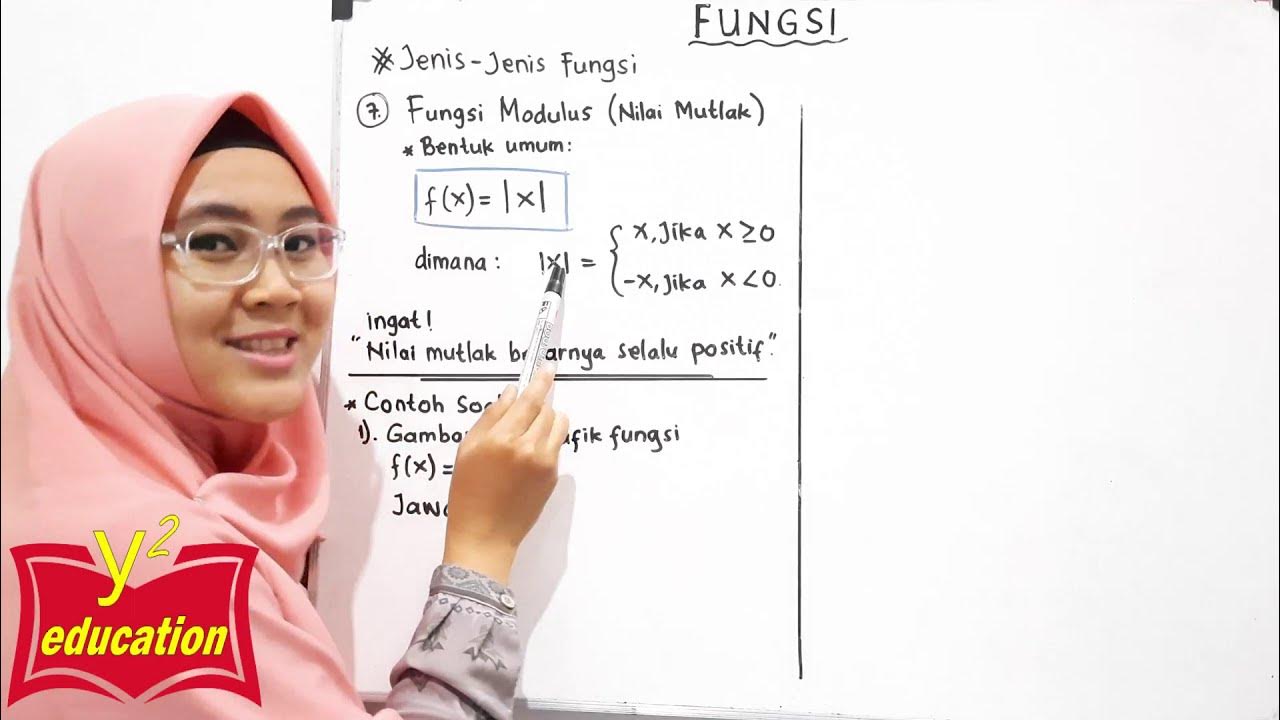Fungsi #Part 15 // Jenis-jenis Fungsi // Fungsi Tangga // Grafik , Domain Kodomain , Range
Summary
TLDRIn this video, the concept of a staircase function (also known as a step function) is explained. The function is represented by intervals where each range of x-values corresponds to a constant output value, creating a 'staircase' effect on the graph. The video walks through an example with specific intervals for x-values, showing how to plot the graph and interpret it. Key topics include domain, range, and injectivity, with the conclusion highlighting different types of functions like constant, linear, and trigonometric. The video aims to make understanding various mathematical functions accessible and clear for students.
Takeaways
- 😀 The topic of the script is about 'step functions' or 'fungsi tangga' in mathematics, specifically their definition and graphical representation.
- 😀 A step function is defined by intervals on the x-axis where the function value remains constant within those intervals, creating a staircase-like graph.
- 😀 The function described in the script has intervals such as: f(x) = -1 when x < -1, f(x) = 0 for -1 ≤ x < 2, f(x) = 2 for 2 ≤ x ≤ 4, and f(x) = 3 for x > 4.
- 😀 The function is visualized on a Cartesian plane with a graph illustrating the different intervals and the corresponding function values.
- 😀 For x values less than -1, the function is -1, and for values between -1 and 2, the function is 0.
- 😀 Between 2 and 4, the function is 2, and for values greater than 4, the function is 3.
- 😀 A key point in the explanation is the use of open and closed intervals, with values at the boundaries either included or excluded as shown by filled or unfilled circles on the graph.
- 😀 The domain of the function includes all real numbers (x ∈ R), as the function is defined for every real number, regardless of the intervals.
- 😀 The range (or codomain) of the function is the set of values the function takes, which is from -1 to 3, excluding 3.
- 😀 The function is not injective (one-to-one) because multiple x values map to the same function value, but it is surjective (onto) because all values in the range are achieved by some x in the domain.
Q & A
What is a step function (fungsi tangga)?
-A step function is a type of function whose graph consists of intervals where the function value is constant. These intervals appear as 'steps' in the graph.
Can you describe the graph of a step function?
-The graph of a step function consists of horizontal segments that represent intervals of constant values. It looks like a staircase, with each horizontal segment corresponding to a different value in the function's range.
What is the specific function example given in the script?
-The function example provided in the script is defined as follows: f(x) = -1 for x ≤ -1, f(x) = 0 for -1 < x ≤ 2, f(x) = 2 for 2 < x ≤ 4, and f(x) = 3 for x > 4.
How do you graph the function f(x) = -1 for x ≤ -1?
-To graph f(x) = -1 for x ≤ -1, draw a horizontal line at y = -1 extending from the left, and indicate that it continues infinitely to the left by adding a leftward arrow.
What happens in the interval -1 < x ≤ 2 for this function?
-In this interval, the function value is 0. Therefore, the graph has a horizontal segment from x = -1 (not included) to x = 2 (included), with the value at y = 0.
How is the function graphed when 2 < x ≤ 4?
-For this interval, the function value is 2. A horizontal segment is drawn at y = 2, starting at x = 2 (not included) and ending at x = 4 (included).
How does the function behave when x > 4?
-For x > 4, the function value is 3. The graph has a horizontal segment at y = 3, starting at x = 4 (not included), and continues to the right with an arrow indicating it goes infinitely.
What is the domain of the step function in the script?
-The domain of the step function is the set of all real numbers, as the function is defined for all x values.
What is the range of the function described in the script?
-The range of the function is the set of values that the function takes, which in this case is the set {-1, 0, 2, 3}.
Why is this step function not injective, and what does that mean?
-This function is not injective because multiple values of x (such as x = 2 and x = 3) give the same function value (2), meaning the function is not one-to-one.
Outlines

This section is available to paid users only. Please upgrade to access this part.
Upgrade NowMindmap

This section is available to paid users only. Please upgrade to access this part.
Upgrade NowKeywords

This section is available to paid users only. Please upgrade to access this part.
Upgrade NowHighlights

This section is available to paid users only. Please upgrade to access this part.
Upgrade NowTranscripts

This section is available to paid users only. Please upgrade to access this part.
Upgrade NowBrowse More Related Video

Komposisi Fungsi | XI SMA| Kurikulum Merdeka

Fixed Point Iteration Method Intuition | Numerical Methods

Perceptron Rule to design XOR Logic Gate Solved Example ANN Machine Learning by Mahesh Huddar

Derivative by increment method (By definition with limit)

Fungsi #Part 13 // Jenis-jenis Fungsi // Fungsi Modulus // Fungsi Mutlak // Grafik, Domain , Range

Matematika Kelas 9 : Fungsi Kuadrat (Part 1 : Bentuk umum dan grafik fungsi kuadrat)
5.0 / 5 (0 votes)